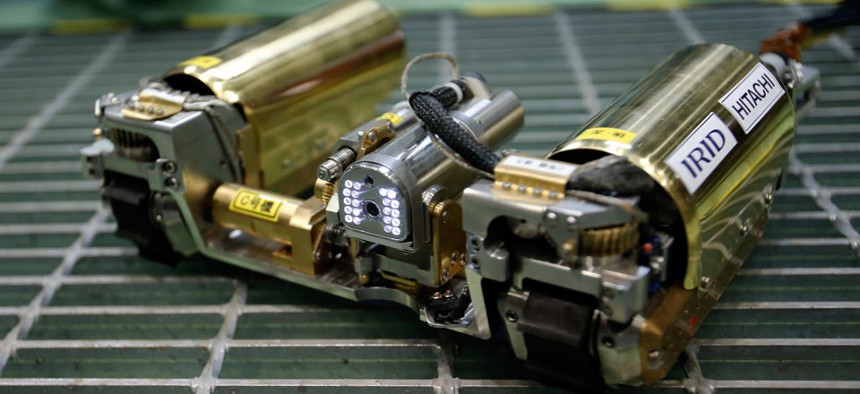Inspector Gadget, but for Nuclear Waste

The snake-like robot, developed by Japanese electronics giant Hitachi and its nuclear affiliate Hitachi-GE Nuclear Energy, is ready to examine in April the damage inside Unit 1 reactor at the Fukushima dai-ichi nuclear plant. Shizuo Kambayashi/AP
Four years after the Fukushima nuclear disaster, robots are cleaning up the contaminated power plant.
It's not safe for humans to spend much time at the Fukushima-Daiichi power plant anymore. Four years ago, a massive tsunami hit the facility, triggering a core meltdown that earned the most severe ranking on the International Nuclear Scale—on par with the Chernobyl disaster in 1986. (It's worth noting, though, that far more radiation was released at Chernobyl than at Fukushima.)
And though the evacuation order for tens of thousands of people who once lived near the plant is expected to be lifted in the next year, the inside of the old power plant is still a mess: melted fuel rods, toxic water, and other debris that must be contained before a more comprehensive clean-up can begin.
And so, in one area of the plant—a spot where a person would risk too much radiation exposure after just 10 minutes—engineers placed a wheeled box the size of a refrigerator, one of the many robots that is cleaning up Fukushima.
It's called a manipulator, and it consists of a robotic arm that emerges from the box and can snake through the power plant to plug leaks. (An earlier manipulator robot that was deployed to find the leaks in the first place has already completed its mission.) Operators can attach various tools to the carbon fiber arm—a cutting tool that uses water jets, and a vent tube filled with grout to patch holes, for instance. Think of it like the Inspector Gadget of robots—one machine with a very long arm that can do all kinds of things.
"The arm itself when it's deployed is essentially a vertical mast, a telescoping tube that's five cylinders nested together just like a pirate's telescope," said Matt Cole, the director for robotics systems and services at Kurion, one of the companies that's contracted to help with the clean-up. "On the bottom of that, two hydraulically-powered pivots—we call it elbows—the elbows are what pivot it. On the end of that pivot is another three sets of telescoping tubes... At the end of that is a plate that allows us to connect any number of different tools."
Kurion designed its manipulators specifically for Fukushima—first testing them in exact mock-ups of the site so engineers could be sure the robot would fit through doorways and access other hard-to-reach spots.
"What we're doing is fairly simple if you were to do it physically," Cole said. "What's challenging is we're doing it remotely 15 feet down and 15 feet out in a totally isolated radioactive area... You have this accident which has caused damage. No electricity, no lights, [and] there's also contamination. So instead of just having a product where we say, 'This is our product and it may or may not fit,' we actually design the machine [for the site]."
Even with seven degrees of movement possible, the robot's work is slow—painstakingly so. The person driving the manipulator uses a set of joysticks to make the arm and its joints move, as well as a touch screen to navigate and control cutting and grouting tools. Cole estimates Kurion is about one-third of the way through a job that will take 18 months to complete—and after this robot is finished its grouting work, the next stage in the clean-up can begin.
"It's not like playing PlayStation," Cole said. "We have some fairly complex controls. This is very slow, you're not flying it around... It's all challenging, primarily because you're just so remote. There's a number of different systems that need to work together simultaneously, and a number of things needs to go right."





